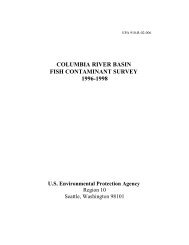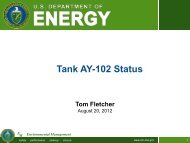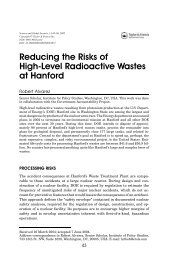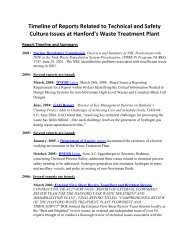Knowing Endangerment - Hanford Challenge
Knowing Endangerment - Hanford Challenge
Knowing Endangerment - Hanford Challenge
Create successful ePaper yourself
Turn your PDF publications into a flip-book with our unique Google optimized e-Paper software.
warnings by safety experts, threatening workers with job loss if they reported injuries, and knowingly<br />
submitting false information regarding lost-time injuries. 19<br />
The 16 exposures also triggered a large scale investigation by the DOE and culminated in a highlevel,<br />
comprehensive Type B Investigation of <strong>Hanford</strong> Tank Farms Vapor Exposures, released in<br />
April of 1992. 20 The Type B Investigation found numerous problems underlying the then primary<br />
tank farms contractor‟s (Westinghouse <strong>Hanford</strong> Corporation (WHC)) inability to protect its tank<br />
farm workers, and concluded there were 37 “judgments of need” to be translated into corrective<br />
action. 21 The Type B Investigation resulted in the implementation of supplied air for workers at 84<br />
of the 177 tanks, constant air monitoring by Industrial Hygiene Technicians (IHT) at all sites where<br />
supplied air was not being used, requirements to characterize of tank contents and vapors, the<br />
creation and implementation of a tank farms Health and Safety Plan (HASP), and a plan to install<br />
permitted ventilation on single shell tanks. Reports of exposures decreased as a result of the<br />
implementation of these controls. Unfortunately, this did not last long.<br />
The Hewitt Report<br />
In July 1996, Westinghouse released a report, Tank Waste Remediation System Resolution of<br />
Potentially Hazardous Vapors Issue, authored by an employee named Elton Hewitt. 22 The Hewitt<br />
report concluded that due to implementation of controls around potential vapor release points,<br />
characterization of tank contents and vapors, and “as a result of better communications regarding<br />
vapor odors and risks” following the Type B Investigation, “employee exposure incidents have<br />
virtually ceased” and the vapor problem had been “resolved.” 23<br />
In reaching this conclusion, Hewitt noted that while ammonia and nitrous oxide compounds routinely<br />
were present in concentrations greater than 5 times permissible exposure limits (PELs) in the<br />
headspace of tanks, when vented, they did not pose a hazard to workers because barriers had been<br />
installed around release points and effective controls were in place. The report went on to assert that<br />
even if control measures failed, because ammonia has such a distinct odor and can be smelled at<br />
levels below the PEL, employees could leave the area before any overexposures occurred. 24<br />
Additionally, while acknowledging that “potential carcinogens have been identified as being present<br />
in the tank headspace,” Hewitt postulated that<br />
these chemicals are present at sufficiently low concentrations so that employees can<br />
be protected from overexposure by maintaining their ammonia exposure level below<br />
its PEL [25 ppm]. By protecting employees from an excess exposure to ammonia,<br />
the resulting exposure to other materials would also be at acceptable levels. 25<br />
19 Id.<br />
20 DOE-RL, 1992 TYPE B INVESTIGATION, supra note 6.<br />
21 Id. at 5.15 – 5.19.<br />
22 Elton R. Hewitt, et. al., WESTINGHOUSE HANFORD COMPANY [hereinafter WHC] , TANK WASTE<br />
REMEDIATION SYSTEM RESOLUTION OF POTENTIALLY HAZARDOUS VAPORS ISSUE (WHC-SD-TWR-RPT-001) (June<br />
24, 1996) [hereinafter HEWITT REPORT].<br />
23 Id. at 2.<br />
24 Id. at 17.<br />
25 Id. at 7-8.<br />
8







